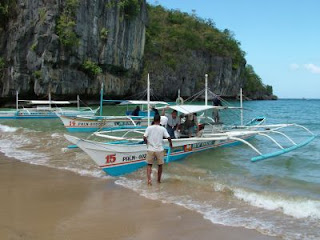Jeepney
are the most popular means of Public Transportation in the Philippines. They were originally made from US military jeeps World War and are known for their flamboyant decoration and crowded seating. They have become a symbol of Philippine culture.
Tricycle and Pedicab
is the Philippine rickshaw. A motorbike or sometimes a bicycle with an attached sidecar. They are decorated like the jeepneys and gadgets are attached here and there. There are various styles of tricycles. Each region has its own type. On Panay Island there are two types: the Aklano type with 2 facing benches in the rear and 1 bench in front. They offer officially 9 passenger places. The Iloilo type has two benches back to back and a small seat in front. They also transport up to 9 people.
They are called Motorela. The passenger room is built around the motorbike and has two facing benches and a seat on each side of the driver.
Tricycles are funny to ride, but they are a pain in the traffic. In towns they block the roads by hundreds, curving around and occupying the smallest slot in the traffic. Their 80 cm3 two stroke engines are weak an smoke heavily. The fact is that the drivers cannot afford 2 stroke oil for the mixture, so they mix used car engine oil in their fuel. The smokescreen in the air is sometimes so thick, that the sun sun is merely a brownish disc. City traffic would break down permanently, if tricycles were allowed within the city limits. A three-wheeled public conveyance operated by pedals, typically one having a hooded cab for two passengers mounted behind the driver.
Bangka
Outrigger canoes are very popular in coastal areas of the Philippines. As an archipelago, these vessels are the most practical means of communication and transportation in the country. Outrigger canoe is known in the Philippines as Bangka. It is a type of canoe featuring one or more lateral support floats known as outriggers, which are fastened to one or both sides of the main hull.
Kalesa
The kalesa is basically a horse drawn carriage, it was introduced to the Philippines in the 18th Century by the Spanish. It was the upper classes mode of transport, only the nobles and officials could afford the luxury of the Kalesa.
You can find the calesa in most of the major tourist traps. The most popular area is Intramuros and you can also see them around Chinatown. In the Ilocos Region the province of Ilocos Sur is also famous for the kalesa, particularly around the capital Vigan. It is well worth a trip in the kalesa as you navigate the cobblestone roads that interlock Vigan.
To the south of the Philippines the calesa can also be found in Cebu.
To the south of the Philippines the calesa can also be found in Cebu.
Intramuros Kalesa
Intramuros is a large area to cover on foot. There is an awful lot to see, from Fort Santiago to Manila Cathedral, with lots in between.
One way of covering the area whilst giving your legs a bit of a rest, is by kalesa.
Most of the kalesas can be found outside Manila Cathedral where they will take you for a trip around Intramuros. The Philippine Kalesa was designed to carry two people and some baggage, although I'm sure more than two would be carried quite easily, specially when I have seen 7 Filipinos on a motorbike! The carriage has small sides and a roof to keep the glaring sun from burning you, two huge wheels hold the carriage up, which are then connected to a scrawny horse by two poles strapped either side of the horse.
One way of covering the area whilst giving your legs a bit of a rest, is by kalesa.
Most of the kalesas can be found outside Manila Cathedral where they will take you for a trip around Intramuros. The Philippine Kalesa was designed to carry two people and some baggage, although I'm sure more than two would be carried quite easily, specially when I have seen 7 Filipinos on a motorbike! The carriage has small sides and a roof to keep the glaring sun from burning you, two huge wheels hold the carriage up, which are then connected to a scrawny horse by two poles strapped either side of the horse.
The carriage is brightly coloured and it looks as though a lot of care has been taken in it's upkeep. A whip is kept in a pipe to thecocheros right hand side and sticks straight up in the air like a radio antenna.
One of the more amusing things with the whip, is the noise it makes as it is pulled from the pipe that holds it. It makes a rasping sound, which the horse hears and immediately trots faster. Obviously the horse associates the noise of the whip coming from the pipe as a chance to speed up before he gets whipped on the but! I'm happy to say that the horse was not whipped at any stage.kalesa drivers who charge way over what they originally quoted, or you were never quoted in the first place and then got hit with a gigantic sum of money at the end.










